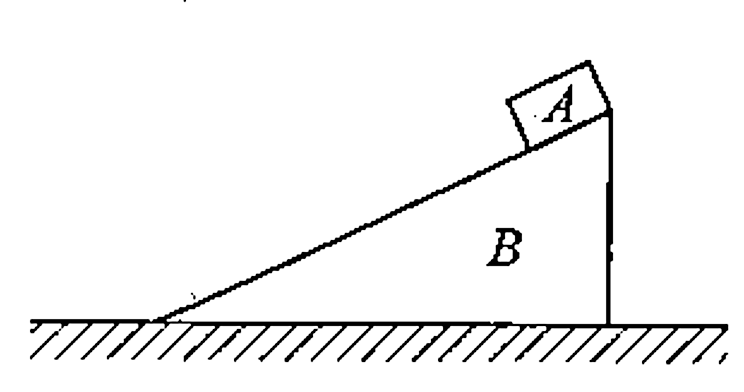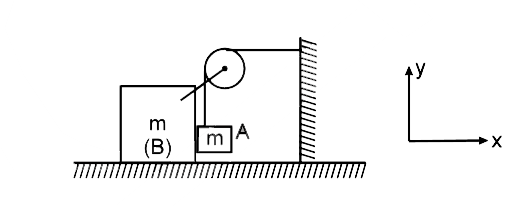In the figure shown, the system is released frrom rest. Find the velocity of block A when block B has fallen a distance l. Assume all pulleys to be massless and frictionless.

The correct Answer is:A
Evidently , when the block B descends by a distance l. The pulley P , descends by a distance l2 , and consequently , the block A , (up). 2v, would be the speed of block B (down).
Net loss in PE of the system
= Loss in PE of block B - gain in P.E., of block A
=mgl−mg(l)2=mg(l)2
Total gain in K.E.=12mv2+12m(2v)2=52mv2
Now, law of conservation of energy demands
Loss in P.E. = Gain in K.E.
mg(l)2=52mv2⇒v3=gl5
v=√gl5.
Topper's Solved these Questions
- WORK, ENERGY, POWER AND COLLISIONBook:A2ZChapter:WORK, ENERGY, POWER AND COLLISIONExercise:Assertion Reasoning
Explore 17 Videos
- WORK, ENERGY, POWER AND COLLISIONBook:A2ZChapter:WORK, ENERGY, POWER AND COLLISIONExercise:NEET Questions
Explore 49 Videos
- WORK, ENERGY, POWER AND COLLISIONBook:A2ZChapter:WORK, ENERGY, POWER AND COLLISIONExercise:Collision
Explore 31 Videos
- WAVES AND ACOUSTICSBook:A2ZChapter:WAVES AND ACOUSTICSExercise:Chapter Test
Explore 30 Videos
Similar Questions
A block A (mass 4M) is placed on the top of a wedge block B of base length l (mass=20M) as shown in figure. When the system is released from rest. Find the distance moved by the block B till the block A reaches ground Assume all surfaces are frictionless.

View SolutionIn the system shown in figure, the block A is released from rest. Find

the acceleration of both blocks ‘A’ and ‘B’.
View Solution
Knowledge Check
Find the acceleration of the block of mass m. Assume pulleys are massless and frictionless.
 Ag/3B2g3Cg2DNone
Ag/3B2g3Cg2DNoneThe system shown in the figure is released from rest. At the instant when mass M has fallen through a distance h, the velocity of m will be
 A√2ghB√2ghMmC√2gh(M−m)m+MD√2gh(M+m)m−M
A√2ghB√2ghMmC√2gh(M−m)m+MD√2gh(M+m)m−M
In the system shown in figure, the block A is released from rest. Find

Tension in the string.
View Solution
Consider a situation as shown in the figure. The system is released from rest. When the block of mass m has falled a distance L, its speed becomes √gL3. Find the friction coefficient μ.
View SolutionFind out the velocity of block B in a pulley block system as shown in figure.

View SolutionIn the system shown in figure, the block A is released from rest. Find

Contact force between ‘A’ and ‘B’.
View SolutionTwo blocks of masses 2m and m are connected by a light string going over a pulley of mass 2m and radius R as shown in the figure. The system is released from rest. Find the angular momentum of system when the mass 2m has descended through a height h. Assume no slipping.

View SolutionThe block shown in figure is released from rest. Find out the speed of the block when the spring is compressed by 1 m

View Solution